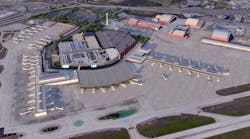Last month while attending the European Business Aviation Convention & Exhibition (EBACE 2011), you couldn’t help but notice an upbeat feeling among exhibitors and attendees alike. As reported on May 23rd on AMTOnline attendance figures were up to nearly 12,751, from 108 countries, with over 500 exhibitors, and 62 aircraft on static display. EBACE was truly a global event and the first time I have attended. An impressive panel of speakers from around the world was assembled for the opening ceremony with the theme, “Linking Communities and Economies.” Many of the discussions and comments heard from emerging areas of the world were very consistent, regardless if they came from representatives from the Middle East, Russia, South America, or wherever.
At the Global Business Aviation Update were business aviation panelists from Brazil, the USA, Europe, the Middle East, Russia, India, Japan, and Asian countries providing an industry update from their countries. There were three points made by representatives from the emerging areas of the world which stuck with me. First, business aviation is rapidly expanding in their countries and many areas have significant orders for new aircraft. Next, the infrastructure in most of these areas is lacking in airports, facilities, ground support, and supporting businesses. And lastly, these emerging areas also lack an experienced skilled workforce including technicians, pilots, managers, and regulators.
It was the representative from Brazil who mentioned that aviation grew there six percent last year -- they have seven airports with runways over 3000 meters in length, limited instrument landing capability, a saturated capacity, challenges with developing a skilled workforce, and tough regulations for importing aircraft parts into the country for maintenance. The representative from India used the phrase, “Strong and steady growth”, but he also warned of the same challenges with the industry demands growing greater than the infrastructure, the workforce, and regulations that fit the business aviation type of operations.
During the question and answer period a senior level executive from one of the business aircraft manufacturing companies offered this comment. He said something to the effect that between an aging aviation workforce in the USA and Europe with low-levels of young replacements, and the growth and demand in emerging countries around the world, he fears there could be a migration of experience and talent to these areas, adding to the future shortage of the aviation workforce in the USA and Europe. He then asked the panel, “What are you going to do to see this doesn’t happen?” The response was, “We will see a shortage of people coming” followed by “we all have a role to play as an ambassador for our industry.”
Ron



